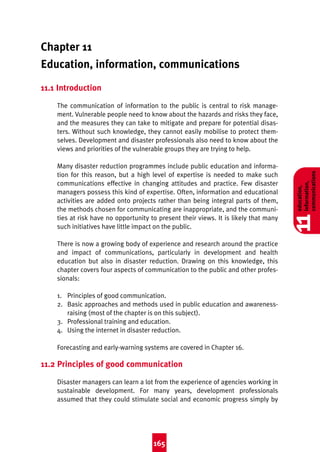This document discusses principles of effective communication for disaster risk reduction. It begins by explaining that communication with communities is important so they understand hazards and risks, and can take protective measures. However, past approaches often failed to understand community perspectives and priorities. Effective communication now involves dialogue with communities to understand their experiences and ensure solutions are appropriate. While expertise from professionals is still valuable, a participatory approach that incorporates community knowledge is most effective. The goal of public education programs should be to create a "culture of safety" where risk reduction is a normal part of life, though achieving this takes a long-term process.




































![Good Practice 4th
10/3/04
2:34 pm
Page 201
chapter 12 policy, regulation, accountability and advocacy
understood. However, a number of innovative techniques are being used to
give disaster victims a voice, and so help disaster agencies make their interventions more appropriate.
Auditing disaster response
Some innovations in accountability take the form of an auditing process.
Case Study 12.1 is a well-known example.
Case Study 12.1
Social audit after Hurricane Mitch
The methods used to collect
information included reviewing
institutional documents, household
surveys, interviews of key informants
and discussion groups. The audit
surveyed more than 10,000 homes in
16 municipalities affected by Mitch.
Community leaders, mayors and
leaders of other local organisations
were also interviewed.
•
The audit provided evidence of the
extent and nature of the losses
suffered (both economic and
psychological), but was particularly
valuable in allowing victims to
201
•
•
•
•
•
•
the coverage of aid (percentage
of victims who had received it);
the value of different items;
which organisations had helped
most;
the orderliness of aid
distribution;
equity in distribution;
coordination with external
organisations; and
how far victims’ views were taken
into account.
Social Audit for the Emergency and
Reconstruction Phase 1 (Managua:
Coordinadora Civil para la Emergencia y
la Reconstrucción de Nicaragua [Civil
Coordinator for the Emergency and
Reconstruction of Nicaragua], 1999).
policy and
regulation
express their views about the aid
they had received. It covered such
questions as:
12
Nicaragua was badly affected by
Hurricane Mitch in October 1998. In
February 1999, a coalition of over
320 non-governmental and social
organisations carried out a ‘social
audit’ in order to incorporate
communities’ points of view into
reconstruction planning.](https://image.slidesharecdn.com/part4-disaster-management-risk-mitigation-131108003009-phpapp02/85/Part4-disaster-management-risk-mitigation-37-320.jpg)










![Good Practice 4th
10/3/04
2:34 pm
Page 212
disaster risk reduction: mitigation and preparedness
7 Living with Disaster [four ten-minute videos], Television Trust for the Environment/Intermediate
Technology Development Group, London, 1996.
8 The Code of Conduct. Principles of Conduct for the International Red Cross and Red Crescent
Movement and NGOs in Disaster Response Programmes (Geneva: IFRC,1994),
www.ifrc.org/publicat/conduct.
9 Humanitarian Charter and Minimum Standards in Disaster Response (Geneva: Sphere Project,
2003), www.sphereproject.org/handbook/hc.htm.
10 Older People in Disasters and Humanitarian Crises: Guidelines for Best Practice (London:
HelpAge International, 2000), www.helpage.org/images/pdfs/bpg.pdf; Older people in disasters (London: British Red Cross Society (NGO Initiatives in Risk Reduction, Case Study 11),
2001), www.redcross.org.uk/riskreduction.
11 A. K. Patel, ‘Understanding Vulnerability: Recent Tools and Methods’, paper presented to the
Duryog Nivaran workshop ‘Understanding Vulnerability: A South Asian Perspective’, Colombo,
21–22 August, 1997.
12 M. R. Bhatt, Budget Analysis and Policy Priority: DISHA’s Experience (Ahmedabad: Foundation
for Public Interest, 1995); ‘A Critique of the Orissa Relief Code’, unpublished report, ActionAid
Orissa, 2000.
13 F. H. Cate (ed), International Disaster Communications: Harnessing the Power of
Communications To Avert Disasters and Save Lives (Washington DC: The Washington
Annenberg Program, 1994), www.annenberg.nwu.edu/pubs/disas; A. Bhatti and M. M.
Ariyabandu, Disaster Communication: A Resource Kit for Media (Islamabad: ITDG South
Asia/Journalists Resource Centre/Duryog Nivaran, 2002).
14 The Times, 29 January 2001, p. 19.
15 For example, G. Siwakoti and R. Pant, ‘Public Interest Litigation in Disaster Mitigation: A
Manual for Activists’, unpublished report for Duryog Nivaran, 1997.
16 B. Wisner, ‘Disasters and Human Rights: Lessons from El Salvador and India’, 2001,
http://online.northumbria.ac.uk/geography_research/radix/resources/xian_science_monitor.rtf.
17 Comité de Emergencia Garifuna de Honduras, ‘Lessons and Experiences from the Garifuna
Coast after Mitch’, contribution to the ISDR email conference for Earth Summit 2002, 11 May
2002, http://earthsummit2002.dyndns.org/pages.
212](https://image.slidesharecdn.com/part4-disaster-management-risk-mitigation-131108003009-phpapp02/85/Part4-disaster-management-risk-mitigation-48-320.jpg)